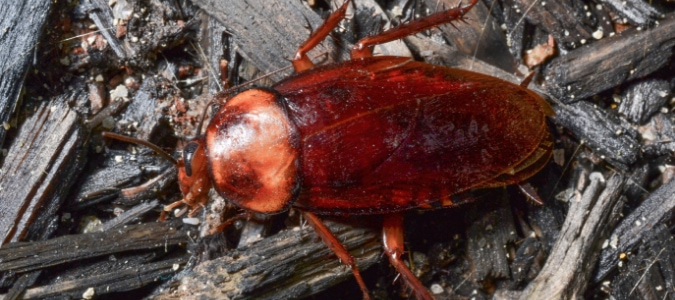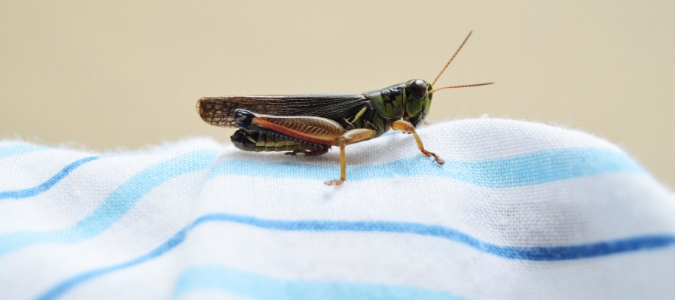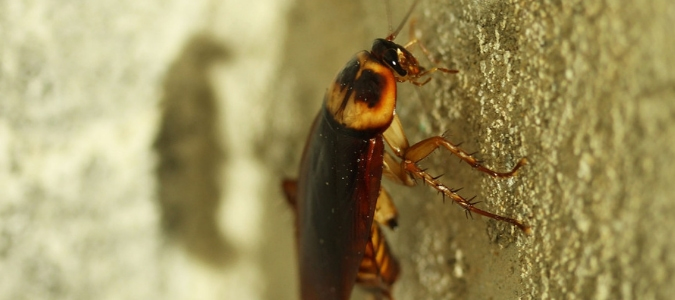
It’s every homeowner’s worst nightmare: you are going through a box in a garage and you unintentionally disturb a cockroach. Or worse still, multiple roaches.
As it (or they) skitter toward the darkest possible corners, you run inside, disgusted and call your spouse, explaining what happened. After you calm down a bit, your partner asks: “What kind of roaches were they?”
A majority of homeowners have no idea what kind of cockroaches they’re dealing with. Most of us aren’t exactly roach experts, after all, and barely anyone likes to get up close and personal with the critters.
Why does it matter, anyways?
Most Texans are surprised to hear that there are about 30 different cockroach species in our state alone, and that the type of roach infesting your home can inform how you can try to get rid of them—and what you might do to prevent future infestations.
Unfortunately, getting rid of roaches may be much easier said than done. A 2017 report by Realtor.com puts one of our state’s largest cities, Houston. at the top of America’s worst pest-infected cities. According to the particularly eye-opening article, two in five Houston households reported seeing roaches. In fact, cockroaches constitute a sizeable percentage of the vermin that plagues Texas as a whole.
In this post, we hope to give Houston-area homeowners and those living throughout the state an exclusive scoop on what they are up against in their fight against pests and how to get rid of cockroaches, specifically.
Before we go into more detail about which species to look out for, let’s cover a few common questions and answers.
Do Roaches Hide In Clothes?
Cockroaches like to live around the same kinds of things that humans do. To make matters worse, roaches very opportunistic, having adapted well to live among us. These creatures will eat almost anything in your home, including scraps from the hard-to-clean spots under the stove and even your pet’s food—no matter how much slobbering the dog’s done.
Your closets and dressers also make cozy hiding areas for these uninvited guests. In addition to hiding in your clothes, cockroaches will often go as far as turning them into nurseries where they lay their eggs!
As cringe-worthy as this all sounds, cockroaches can and do hide in clothing and are also capable of doing lots of damage to your clothes. Food and drink spills, body fluids and perspiration and even laundry starch can attract roaches to clothes. As they try to eat away at these stains, roach activity inevitably cuts holes into the fabric.
Do Cockroaches Jump Like Crickets?
Unlike crickets, roaches do not jump. As you have probably witnessed one more than one occasion, cockroaches move around by running.
How fast? A roach can run about 50 body lengths per second. At this rate, the legs of the cockroach will be moving back and forth at a speed of about 27 times per second!
One reason we may wonder whether cockroaches jump is that some cockroaches can also fly. Yikes!
What Causes The Sudden Appearance Of Cockroaches In A Home?
Most cockroaches spend their entire lives outdoors. Only a few species are indoor pests. Nevertheless, outdoor species may, on various occasions, temporarily migrate to indoor breeding areas. When roaches move into a home, they are not only a nuisance, but also a health risk.
The spot where the maximum cockroach infestation occurs depends on the roach species that’s invading your home. So, let’s go over the roaches you are most likely to encounter in the Houston area and other parts of the state.
Roaches In Houston To Watch For
Houston is home to many of the roaches that are commonly seen in Texas. Species include:
- German cockroach (Blattella germanica)
- Brown-banded cockroach (Supella longipalpa)
- America cockroach (Periplaneta americana)
- Smokybrown cockroach (Periplaneta fuliginosa)
- Oriental cockroaches (Blatta orientalis)
Where are you likely to find these common household pests?
German roaches invade places that are close to sources of food, such as kitchen drawers and cupboards. American roaches infest bathrooms, basements, kitchens and laundry rooms. Oriental roaches will be found close to water, such as around kitchen sinks. You’re more likely to find brown-banded roaches inside appliances, such as TVs, radios, computers and other small electronics. And finally, smokybrown roaches may be found near artificial sources of light, such as by lamps and TVs.
Let’s look at each species in a bit more detail.
German Cockroach
What are German roaches and what else do I need to know about this species? These roaches are found everywhere in the world. Unlike some species, German roaches have a high rate of reproduction. All it takes is a single fertile female to invade a home, and within one year, there will be over 30,000 roaches living inside.
If adequate pest control measures aren’t implemented, a house can easily get overrun with these disease-carrying insects in just a few months’ time.
Appearance
How can you tell this type of roach from any other? Here are some pointers:
- It’s quite easy to tell the German cockroach from other types of roaches because they have two dark stripes running longitudinally on its pronotum, which is the top section of the back.
- Adults are a little over half an inch long.
- These pests are light brown in color.
Life Cycle
What should you know about a German roach’s life stages? For starters:
- Females lay 35-40 eggs.
- Roach mothers carry these eggs in an egg case (ootheca) until they are ready to hatch.
- The eggs hatch after about one month. A baby cockroach is called a nymph.
- Nymphs may take anywhere from six weeks to six months to mature into adult German roaches.
- Generally, German cockroaches produce three to four generations every year. You do the math and understand how it’s best to get the problem under control quickly!
Habits
What other information can help you better understand this pest in order to control its spread? You should know that?
- German cockroaches are predominantly indoor pests.
- These creatures prefer conditions that are wet and humid, such as in the kitchen and in bathrooms.
- German cockroaches can fly, but only for very short distances.
Brown-Banded Cockroach
Like the German cockroach, the brown-banded roach is a common household pest. Nonetheless, German roaches and these cockroaches will rarely share indoor hiding spots.
Appearance
How can you identify this species? Here are some things to look for:
- The most noticeable characteristics of the brown-banded roach are the yellow-brown stripes that run across its abdomen and wings.
- Male brown-banded roaches have a dark-brown base and are golden-tanned toward the tips of their wings.
- Females have dark-brown bodies and reddish-brown wings.
Life Cycle
How is the brown-banded roach different from other types of roaches? Here are a few distinct features:
- Female brown-banded cockroaches lay about 18 eggs in an ootheca. Females carry the ootheca for 24 to 36 hours.
- The eggs hatch into nymphs after between one and three months.
- Brown-banded cockroach nymphs take 13 to 45 weeks to mature into adults.
Habits
What other information is crucial to know to protect yourself against a brown-banded roach invasion? Keep these points in mind:
- Unlike many other species, these roaches tend to avoid moist places.
- Brown-banded roaches love warm environments, though, such as appliance motors. These creatures will also find harborage in ceilings and attics of heated buildings.
- These roaches are mostly active at night and have a high preference for materials that have a high starch content.
- This species moves by crawling. Only the males fly, and they mostly only do so in warm climates.
Oriental Cockroach
Some people refer to the oriental cockroach as the “water bug”, or a black beetle. This glossy black roach looks like a slow-moving bug. It’s noted for giving off a distinctive foul and musty odor.
Appearance
To identify this species, note that:
- The body of an oriental cockroach is glossy and either black or dark brown.
- Adults are usually about one and a quarter inch long.
- The wings of a male oriental cockroach are shorter than its body, while those of the female cockroach are underdeveloped.
Life Cycle
How long is the reproductive cycle of an oriental cockroach? The following facts are helpful to get an idea of how quickly a roach can turn into an infestation:
- Female oriental roaches lay about 16 eggs in an ootheca.
- The eggs hatch into nymphs after two months.
- Oriental cockroach nymphs take anywhere from 6 to 18 months to mature into adults.
Habits
What distinct traits about a water bug make them easier or harder for homeowners to control on their own? We have learned that:
- Oriental roaches are uniquely adapted for survival in the natural environment. The oriental roach is thus not frequently encountered indoors since it also prefers to stay out of sight of humans.
- These roaches primarily feed on decayed organic matter and garbage, so people most often find oriental roaches in rubbish heaps and leaf litters.
- In the houses, oriental roaches can often be found thriving in dark, cool, damp places such as sinks, drains and basements.
- These roaches are incapable of flight. Oriental cockroaches run rather than fly.
American Cockroach
These are the largest types of cockroaches that are found in American homes. Some people refer to the American cockroach as the “palmetto bug.” Of note is that this is one of the roaches with the longest lifespan, with the adult capable of surviving for as long as two years.
Appearance
If you are trying to distinguish between roaches you have run across in your home, you’ll want to remember that:
- The American cockroach is dark-red or brown with light yellow edges on its exoskeleton.
- The adult measures one to three inches in length.
- The wings of male roaches are typically longer than the body. The wings of female cockroaches just overlap the abdomen.
- When you look at the back (dorsal side) of the head of the American roach, you can make out a crude figure 8.
Life Cycle
Some critical information about these roaches is that:
- The female lays as many as 16 eggs into an ootheca. The female carries the ootheca around for several days. The oothecae are then deposited in groups and often cemented down.
- The eggs hatch into nymphs after one to two months.
- American roaches need 6 to 12 months to mature into adults. However, sometimes they may take up to 15 months to reach maturity.
Habits
- The American cockroach is predominantly found on trees.
- When they move indoors, they have a preference for humid, dark, and undisturbed places such as basements, roof voids, subfloors, bathrooms, laundry rooms, and kitchens.
- Adult American roaches can fly.
Smokybrown Cockroaches
Smokybrown roaches are nocturnal. This type of roach is attracted to light, and often enter homes upon seeing it.
Appearance
Was that a smokybrown roach that ran across your bathroom floor late at night? These facts might help you decide:
- Smokybrown roaches have a uniformly dark-mahogany or black pronotum.
- Adults are about an inch anda half long.
- The wings of the adult are usually longer than the body.
Life Cycle
How long will it take for these roaches to multiply? Smokybrown roaches share the following characteristics:
- The female lays about 24 eggs in an ootheca.
- Smokybrown roach eggs hatch into nymphs after about 50 days.
- The nymphs take 10 to 12 months to become adults.
Habits
What information can help you locate these types of roaches in your home? Smokybrown roaches have the following habits:
- The smokybrown’s body gets dehydrated easily. These roaches, therefore, live in places that are moist and damp.
- Smokybrown cockroaches have many outdoor shelters and will rarely migrate indoors.
- Smokybrown roaches are excellent fliers. They can be seen at night flying towards and around light sources.
Signs Of Roaches
While roaches don’t sting or bite, they can transmit disease, contaminate your food, worsen allergies and damage belongings. Since many types of roaches only emerge at night, how do you know if you may have a roach problem?
Here are some of the telltale signs of a cockroach infestation:
Cockroach Feces
The excrement from cockroaches is usually cylindrical, quite tiny and brown or black in color.
Roach Skins
Roach nymphs molt five to eight times during their maturation process. The skin that these creatures shed when molting can be seen near their shelters.
Unusual Odor
A cockroach infestation is marked by an unpleasant, lingering odor that’s strongest in areas with the highest infestation.
Smear Marks
As roaches scuttle along walls, floors and other surfaces, they may leave brown, irregularly-shaped smear marks.
Roach Sightings
It should go without saying that when you actually see cockroaches in your home, it’s a strong indication that you’ve been infested.
ABC Can Solve Your Roach Problem
Once you find that cockroaches have invaded your home, you’ll want to act quickly before your population increases further. The roach control professionals at ABC Home & Commercial use tried-and-true strategies to kick roaches out of our house and prevent subsequent cockroach entry into your home. With ABC’s help, you won’t have to worry about what kind of roach infested your home, and your roach problem will soon be a thing of the past.



